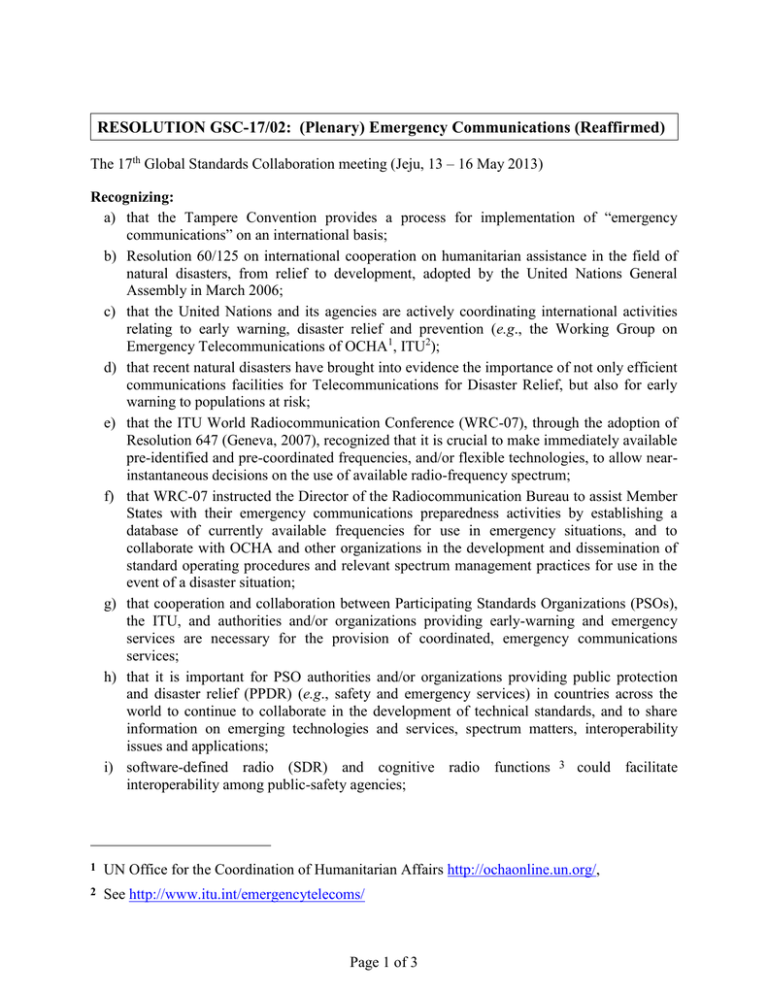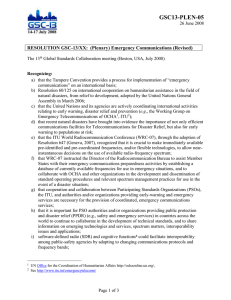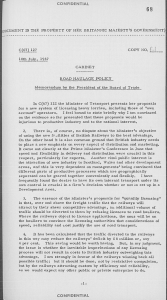Document 12900553
advertisement

RESOLUTION GSC-17/02: (Plenary) Emergency Communications (Reaffirmed) The 17th Global Standards Collaboration meeting (Jeju, 13 – 16 May 2013) Recognizing: a) that the Tampere Convention provides a process for implementation of “emergency communications” on an international basis; b) Resolution 60/125 on international cooperation on humanitarian assistance in the field of natural disasters, from relief to development, adopted by the United Nations General Assembly in March 2006; c) that the United Nations and its agencies are actively coordinating international activities relating to early warning, disaster relief and prevention (e.g., the Working Group on Emergency Telecommunications of OCHA1, ITU2); d) that recent natural disasters have brought into evidence the importance of not only efficient communications facilities for Telecommunications for Disaster Relief, but also for early warning to populations at risk; e) that the ITU World Radiocommunication Conference (WRC-07), through the adoption of Resolution 647 (Geneva, 2007), recognized that it is crucial to make immediately available pre-identified and pre-coordinated frequencies, and/or flexible technologies, to allow nearinstantaneous decisions on the use of available radio-frequency spectrum; f) that WRC-07 instructed the Director of the Radiocommunication Bureau to assist Member States with their emergency communications preparedness activities by establishing a database of currently available frequencies for use in emergency situations, and to collaborate with OCHA and other organizations in the development and dissemination of standard operating procedures and relevant spectrum management practices for use in the event of a disaster situation; g) that cooperation and collaboration between Participating Standards Organizations (PSOs), the ITU, and authorities and/or organizations providing early-warning and emergency services are necessary for the provision of coordinated, emergency communications services; h) that it is important for PSO authorities and/or organizations providing public protection and disaster relief (PPDR) (e.g., safety and emergency services) in countries across the world to continue to collaborate in the development of technical standards, and to share information on emerging technologies and services, spectrum matters, interoperability issues and applications; i) software-defined radio (SDR) and cognitive radio functions 3 could facilitate interoperability among public-safety agencies; 1 UN Office for the Coordination of Humanitarian Affairs http://ochaonline.un.org/, 2 See http://www.itu.int/emergencytelecoms/ Page 1 of 3 j) that significant activity in relation to emergency communications, including such issues as E911/E112/E119 etc., priority access (e.g., wireless priority service or WPS), priority routing [e.g., Government Emergency Telecommunications Service (GETS)], location identification, special handling for emergency communications, public protection and disaster relief activities, is currently being undertaken and expedited in ITU and a range of national, regional and international Standards Development Organizations (SDOs); k) that future applications for emergency communications will utilize narrowband, wideband, and broadband techniques in fixed, mobile, Internet, broadcast and other electronic communications networks; and l) that in the future, operations that were available and effective in a circuit-switched network (e.g., PSTN), for example, traffic pre-emption, flow control, refusal, and preferential access, may not be possible or effective in current and future packet-based networks unless those needs are identified and communicated to those doing the standardization.4 Considering: a) that emergency communications can be partitioned into concerns covering communication (1) from individuals/organizations 5 to authorities and/or organizations providing emergency services, (2) between and among such authorities, (3) from such authorities to individuals/organizations and (4) among affected individuals and organizations; b) that it is important for PSOs, authorities and/or organizations providing emergency services in countries across the world to continue to collaborate in the development of technical standards, common definitions and terminology, and to share information on emerging technologies and services that can be used for emergency communications; and c) that emergency communications facilities are needed not only on legacy systems, but also in future systems. Resolves: 1) to establish a continuing area of work on “emergency communications” to further encourage cooperation and the sharing of information among SDOs, ITU, and others 3 With regard to the 2011 World Radiocommunication Conference (WRC-11), agenda item 1.19 addresses the consideration of regulatory measures and their relevance, in order to enable the introduction of software-defined radio and cognitive radio systems, based on the results of ITU-R studies. 4 For example in the USA the National Security Telecommunications Advisory Committee (NSTAC) studies such things as “potential impact of new technologies on NS/EP telecommunications,” and makes recommendations to the President of the United States. http://www.ncs.gov/nstac/reports/fact_sheet/NSTAC%20Fact%20Sheet%200309-05.pdf 5 Use of the term “individuals/organizations” is intentionally broad and intended to include citizens, non-citizens and visitors, employer-to-employee emergency communications, as well as employer-to-employer, and also encompasses the unique concerns for persons with disabilities and those individuals who may not be fluent in the language(s) or dialects in use in the locus of the emergency or disaster. Page 2 of 3 2) 3) 4) 5) working on standardization activities relating to communications in emergency situations, in particular addressing: - communications from individuals/organizations to authorities; - communications between and among authorities; - communications from authorities to individuals/organizations; and - communications among affected individuals/organizations; including, but not limited to, developing standards applicable to existing and future systems for: - technical means for delivery of early warnings or alerts from authorities to citizens (e.g., in support of disaster prediction and detection); - priority access to emergency call access numbers; - provision of location information; - suitable technologies for use in networks dedicated to public protection and disaster relief communications; - interoperability between public networks and networks dedicated to emergency communications; and - priority access by emergency services personnel to communications services; to encourage ongoing cooperation and collaboration among national, regional and international activities that relate to emergency communications, such as Project MESA and to provide forums to collect aggregated government users’ needs at the local, state or provincial, or national/international level; to encourage PSOs to support ongoing national activity and cooperation between industry, PSOs, administrations and authorities in the establishment of emergency communications and harmonize terminology used, for example, use of the term “emergency communications” and not “emergency telecommunications” in order to embrace and include the widest range of new systems, services, and technologies and not just “telecommunications”; to draw to the attention of PSOs the need to examine the characteristics of providing emergency communications over packet-based networks, including Next Generation Networks; and to enhance collaborative efforts at the international level to make most efficient use of resources and enable a timely and focused approach in the global deployment of systems and solutions. Page 3 of 3






